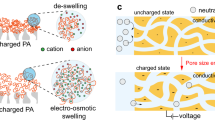Abstract
Electrostatic potentials created by fixed or induced charges regulate many cellular phenomena including the rate of ion transport through proteinaceous ion channels. Nanometer-scale pores of these channels also play a critical role in the transport of charged and neutral macromolecules. We demonstrate here that, surprisingly, changing the charge state of a channel markedly alters the ability of nonelectrolyte polymers to enter the channel's pore. Specifically, we show that the partitioning of differently-sized linear nonelectrolyte polymers of ethylene glycol into the Staphylococcus aureus α-hemolysin channel is altered by the solution pH. Protonating some of the channel side chains decreases the characteristic polymer size (molecular weight) that can enter the pore by ∼25% but increases the ionic current by ∼15%. Thus, the “steric” and “electric” size of the channel change in opposite directions. The results suggest that effects due to polymer and channel hydration are crucial for polymer transport through such pores.
Similar content being viewed by others
Author information
Authors and Affiliations
Additional information
Received: 16 March 1997 / Accepted: 24 April 1997
Rights and permissions
About this article
Cite this article
Bezrukov, S., Kasianowicz, J. The charge state of an ion channel controls neutral polymer entry into its pore. Eur Biophys J 26, 471–476 (1997). https://doi.org/10.1007/s002490050101
Issue Date:
DOI: https://doi.org/10.1007/s002490050101




